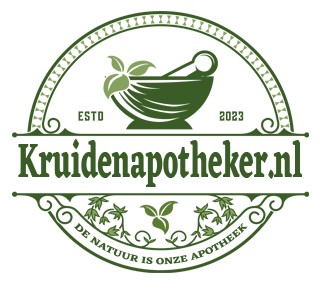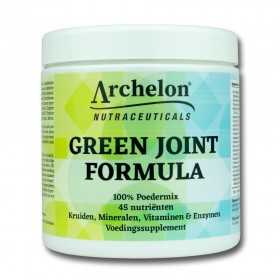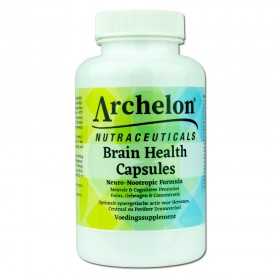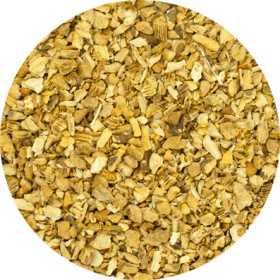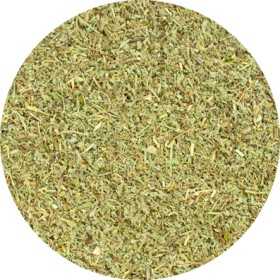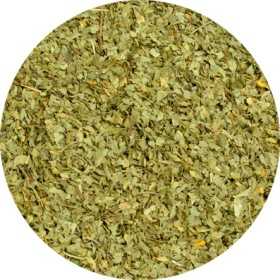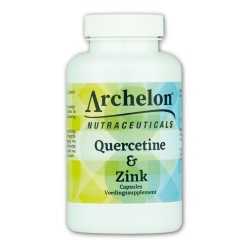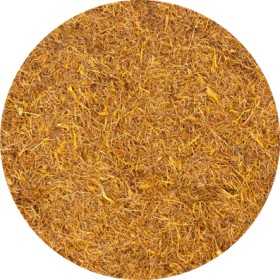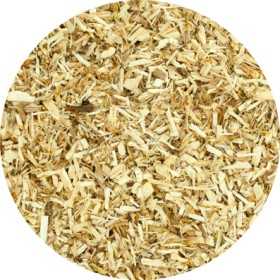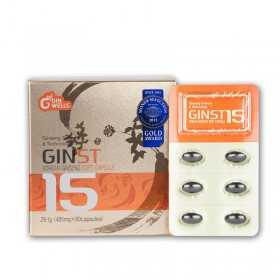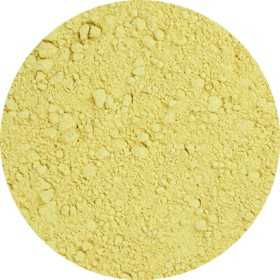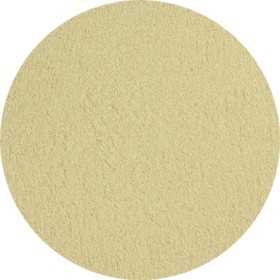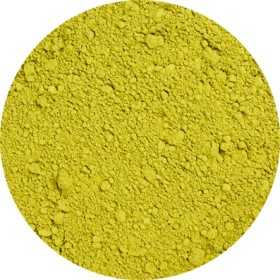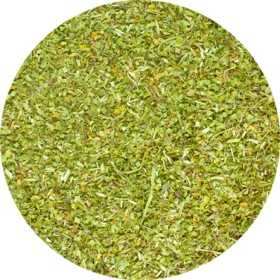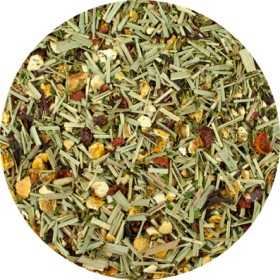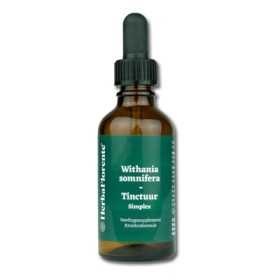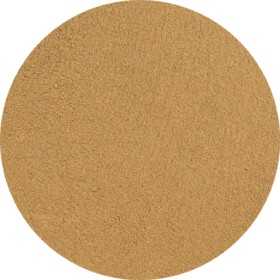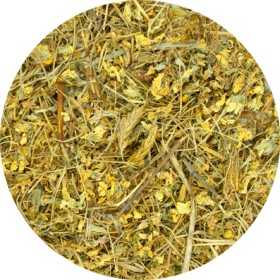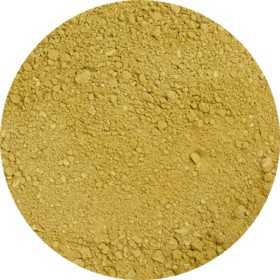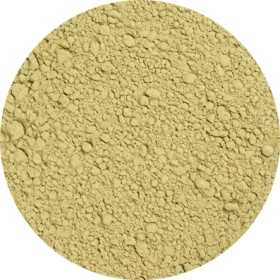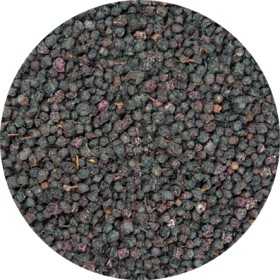Best sellers
There are 392 products.
Kelp - Vesiculosus Fucus
Kelp, a member of the brown algae (Laminariales) family, thrives in the cold waters of the major oceans. This large species of seaweed is an excellent source of iodine, an essential element for healthy thyroid function in humans.
In Asia, especially Japan, seaweed has been an integral part of the daily diet for centuries. A well-known kelp species is kombu (Laminaria japonica), which is often cooked with rice for sushi. In addition to being one of the largest plants in the world, kelp is known for growing extremely quickly, sometimes up to three meters per day.
In Asia, especially Japan, seaweed has been an integral part of the daily diet for centuries. A well-known kelp species is kombu (Laminaria japonica), which is often cooked with rice for sushi. In addition to being one of the largest plants in the world, kelp is known for growing extremely quickly, sometimes up to three meters per day.
€2.50
From: €2.50
Gentian (Yellow) - Gentiana lutea
The large yellow gentian, also known as Gentiana lutea, is a perennial plant belonging to the gentian family (Gentianaceae). This plant naturally occurs in European mountains, mainly at altitudes up to 2200 meters.
In ancient times, yellow gentian was used as a medicine against various ailments, including fever, gout, hypochondria, malaria, intestinal parasites and even alcoholism. Today the plant is mainly used for its bitter properties, such as stimulating the appetite, and as an ingredient in liqueurs, such as gentian liqueur.
In ancient times, yellow gentian was used as a medicine against various ailments, including fever, gout, hypochondria, malaria, intestinal parasites and even alcoholism. Today the plant is mainly used for its bitter properties, such as stimulating the appetite, and as an ingredient in liqueurs, such as gentian liqueur.
€4.80
From: €4.80
Smooth rupturewort - Herniaria glabra
Smooth rupturewort (Herniaria glabra) is a rare plant from the carnation family (Caryophyllaceae), which occurs as an annual, biennial or perennial herbaceous plant. It blooms from June to October.
Originally, the plant was used to treat hernias. It was also used against dropsy and to stimulate the kidneys.
Originally, the plant was used to treat hernias. It was also used against dropsy and to stimulate the kidneys.
€2.00
From: €2.00
Parsley - Petroselini - Cut
Parsley (Petroselinum crispum) is a biennial, winter-hardy herbaceous plant belonging to the lacecap family (Apiaceae). It is used extensively in European, American and Middle Eastern cuisine for its fresh taste.
To the ancient Greeks, parsley symbolized joy and was used together with marjoram as a hangover remedy. The Romans spread the use of this herb throughout Western Europe. In the Middle Ages, parsley served as a vegetable and was grown, among other things, in the imperial gardens of Charlemagne.
Adding parsley (usually the leaves) to dishes is best done just before serving. It is often combined with garlic in butter to make herb butter and can also be used in salads. Ground parsley seeds serve as a spice.
To the ancient Greeks, parsley symbolized joy and was used together with marjoram as a hangover remedy. The Romans spread the use of this herb throughout Western Europe. In the Middle Ages, parsley served as a vegetable and was grown, among other things, in the imperial gardens of Charlemagne.
Adding parsley (usually the leaves) to dishes is best done just before serving. It is often combined with garlic in butter to make herb butter and can also be used in salads. Ground parsley seeds serve as a spice.
€2.20
From: €2.20
Quercetin & Zinc
Quercetin is a flavonoid, also called bioflavonoid. This natural plant compound is found in various plants, fruits and vegetables. Flavonoids are responsible for the vibrant colors (pigments) in these plants and come in various shades. They play a crucial role in plant metabolism, regulate growth, and provide protection against UV light, oxidation and heat.
Zinc is available in different forms. Zinc bisglycinate has a very good bioavailability. It is a chelated form of zinc bound to two (bis) molecules of the amino acid glycine which has more benefits for the body. Zinc has a very wide range of action and is involved in many body processes. Zinc is essential for the activity of more than 300 enzymes that have the zinc ion as a cofactor.
Zinc is available in different forms. Zinc bisglycinate has a very good bioavailability. It is a chelated form of zinc bound to two (bis) molecules of the amino acid glycine which has more benefits for the body. Zinc has a very wide range of action and is involved in many body processes. Zinc is essential for the activity of more than 300 enzymes that have the zinc ion as a cofactor.
€34.95
Magnolia Berry (Schisandra) - Schisandrae chinensis - Whole
Schisandra, also known as the Schisandra berry (Schisandra chinensis), is known as one of the most important herbs in traditional Chinese medicine for promoting energy and vitality, and reducing stress. This dark red berry is rich in antioxidants, strengthens the immune system and promotes overall vitality. In addition, it provides protection and support to the liver and respiratory tract.
Schisandra has been used in traditional Chinese herbal medicine for over 2000 years. Only the berry with its seeds are used, harvested after the first frost and then dried in the sun. Schisandra is known as one of the most important herbs for promoting vitality.
Schisandra has been used in traditional Chinese herbal medicine for over 2000 years. Only the berry with its seeds are used, harvested after the first frost and then dried in the sun. Schisandra is known as one of the most important herbs for promoting vitality.
€6.95
From: €6.95
Corn Silk - Zea mays Conc.
Dried corn silk, also called stigmas, are used in herbal medicine. When fresh, these hairs are green in color, but once dried they turn dark brown to black.
Corn silk, also known as corn beard, can have beneficial effects on fluid balance, bladder inflammation (soothing) and irritation of the urinary tract (soothing).
Corn silk, also known as corn beard, can have beneficial effects on fluid balance, bladder inflammation (soothing) and irritation of the urinary tract (soothing).
€2.00
From: €2.00
Elm - Ulmi camp. - Cut
The elm (Ulmus), also known as olm, is a genus of deciduous trees. These trees have feather-veined leaves with a serrate or double-serrate leaf edge. They bloom before the leaves appear, with small green perianths whose petals are fused together. Above the perianths are the stamens with purple anthers and the pistil. The seeds of the elm are flattened and have a broad, winged edge. Elms thrive best in fairly nutrient-rich, moist and calcareous soil.
€2.00
From: €2.00
ILHWA GINST15 Korean Ginseng Soft Capsules - 60 caps
These capsules with GINST15 are packed in easy to take soft gel capsules.
With GINST15, the ginsenosides are 15x better absorbed into the blood and absorption is 4x faster than with regular ginseng! For example, if you take the standard ginseng, it will take longer than 12 hours for your body to fully absorb it, with the GINST15 extract this takes a maximum of 3 to 4 hours!
Especially ideal if you have difficulty with the taste and smell of ginseng. The capsules are packed in blisters of 6 capsules each, making it easier to take along. You will not forget them anymore!
Soft capsules with hydrolyzed ginseng extract.
With GINST15, the ginsenosides are 15x better absorbed into the blood and absorption is 4x faster than with regular ginseng! For example, if you take the standard ginseng, it will take longer than 12 hours for your body to fully absorb it, with the GINST15 extract this takes a maximum of 3 to 4 hours!
Especially ideal if you have difficulty with the taste and smell of ginseng. The capsules are packed in blisters of 6 capsules each, making it easier to take along. You will not forget them anymore!
Soft capsules with hydrolyzed ginseng extract.
€44.21
€58.95
Olive - Olea europaea
Olive leaves, from the wild olive tree (Olea europaea), are naturally rich in antioxidants. Originally native to western Asia, Egypt and Syria, these trees are now a distinctive sight throughout the Mediterranean region, as well as in regions such as South America, the southern United States, southern Australia and the tropics. Olive leaf tea has been consumed in the Mediterranean for centuries, and this is not surprising given the known antioxidant properties of olive leaves. It is therefore no coincidence that the olive tree is often referred to as the 'tree of life'.
€2.25
From: €2.25
Artichoke - Cynaria scolmycus
The artichoke (Cynara scolymus) is a plant that originates from the Mediterranean region. People eat the closed green or purple flower buds as vegetables. The artichoke leaf has a slightly bitter taste. This plant has been consumed for centuries for the support it provides to digestion and the cleansing effect of the liver, thanks to its high concentration of antioxidants.
The artichoke is rich in various nutrients and phytonutrients. It contains beta-carotene, vitamin C, vitamin B, and minerals such as calcium, magnesium and potassium. It also contains flavonoids, enzymes and tannins.
The artichoke is rich in various nutrients and phytonutrients. It contains beta-carotene, vitamin C, vitamin B, and minerals such as calcium, magnesium and potassium. It also contains flavonoids, enzymes and tannins.
€2.95
From: €2.95
Fenugreek - Foenugraeci graecum
Fenugreek (Trigonella foenum-graecum), also known as fenugreek, boxhorn trefoil or Greek hay, is known for its various health benefits. It can help stimulate appetite, support the immune system and promote fat metabolism.
This versatile plant is mainly used as a spice in Indian cuisine. The aromatic leaves of fenugreek are also used to mask the bitter taste of medicines. Originally from the Mediterranean region, fenugreek later gained popularity in Asia.
Fenugreek is rich in essential minerals such as iron and copper. In addition, it contains saponins and coumarins, where coumarins are known for their pleasant hay-like scent.
This versatile plant is mainly used as a spice in Indian cuisine. The aromatic leaves of fenugreek are also used to mask the bitter taste of medicines. Originally from the Mediterranean region, fenugreek later gained popularity in Asia.
Fenugreek is rich in essential minerals such as iron and copper. In addition, it contains saponins and coumarins, where coumarins are known for their pleasant hay-like scent.
€2.00
From: €2.00
Eleutherococcus (Siberian Ginseng) - Eleutherococcus
Siberian ginseng (Eleutherococcus senticosus) has had a good reputation in both China and Russia for centuries as a supporter of the immune system. Siberian ginseng root extract is beneficial for memory and concentration.
The carrots are a rich source of beta-carotene, vitamins B1, B2, C and E, and they are high in eleutherosides. It is important not to confuse Siberian ginseng with its Korean variant (Panax ginseng) or the American one (Panax quinquefolius). Not only do the names differ, but also the properties.
The carrots are a rich source of beta-carotene, vitamins B1, B2, C and E, and they are high in eleutherosides. It is important not to confuse Siberian ginseng with its Korean variant (Panax ginseng) or the American one (Panax quinquefolius). Not only do the names differ, but also the properties.
€2.80
From: €2.80
Damiana - Damianae mex. (Turnera diffusa) - Grounded
Damiana (Turnera diffusa) is a shrub native to southern Texas in the United States, as well as Central America, Mexico, South America and the Caribbean. It belongs to the Passifloraceae family and has been used by the Mayan Indians for centuries for its known effects on libido. Both men and women benefit from the libido-supporting properties of damiana, which is also known for its stress-reducing effect.
In Mexico, women often prepare tea from the fragrant leaves of the damiana shrub or smoke them to stimulate their feelings of pleasure. Damiana leaf contains several active substances, including beta-sitosterol, arbutin and alkaloids.
In Mexico, women often prepare tea from the fragrant leaves of the damiana shrub or smoke them to stimulate their feelings of pleasure. Damiana leaf contains several active substances, including beta-sitosterol, arbutin and alkaloids.
€4.40
From: €4.40
American Skullcap - Scutellaria lateriflora
Skullcap (Scutellaria) is a versatile genus of both annual and perennial plants, belonging to the Lamiaceae family. The genus includes about two hundred species, all of which are characterized by their characteristic, calyx-shaped flowers. These flowers are distinguished by clearly visible upper and lower lips. The name "Scutellaria" is derived from the Latin word "scutella", which means "small shield" or "saucer", and refers to the shape of the calyx.
€6.25
From: €6.25
Citrus Blend Herbal Tea
Herbal tea composed of various herbs
Delicious for every moment
Delicious for every moment
€3.95
Ashwagandha (Winter Cherry) Tincture - Withania somnifera Tincture
Single herbal tincture made with dried root of Withania somnifera (Ashwagandha/Winter Cherry).
In Ayurvedic medicine, ashwagandha is known as a 'rasayana', meaning it is used to support both physical and mental health. It has a calming effect and is used to sleep better and promote a balanced mind. In India, where this herb originates, it is believed to support male potency and female health, often compared to the strength and vitality of a horse.
In Ayurvedic medicine, ashwagandha is known as a 'rasayana', meaning it is used to support both physical and mental health. It has a calming effect and is used to sleep better and promote a balanced mind. In India, where this herb originates, it is believed to support male potency and female health, often compared to the strength and vitality of a horse.
€10.95
Comfrey Tincture - Symphytum officinalis Tincture
Single herbal tincture made with dried root of Symphytum officinalis (Comfrey).
The common comfrey (Symphytum officinale) is common in the Netherlands and Belgium. Comfrey belongs to the rough-leaved family (Boraginaceae). It is a genus of plants consisting mainly of perennial herbs, not shrubs or trees. The calyx of the flower is cut by a quarter or completely, while the leaves are elongated to lanceolate and scattered.
Comfrey is traditionally used for ointments, wraps and compresses that help with broken bones, sprains and bruises.
The common comfrey (Symphytum officinale) is common in the Netherlands and Belgium. Comfrey belongs to the rough-leaved family (Boraginaceae). It is a genus of plants consisting mainly of perennial herbs, not shrubs or trees. The calyx of the flower is cut by a quarter or completely, while the leaves are elongated to lanceolate and scattered.
Comfrey is traditionally used for ointments, wraps and compresses that help with broken bones, sprains and bruises.
€12.95
Pau D'arco - Tabeuiae
Pau d'arco (Tabebuia avellanedae) is an imposing tree that thrives in the Amazon rainforest. The bark of the pau d'arco has been used for centuries in traditional herbal medicine for its diverse uses, including its supportive effects on the immune system.
The inner layer of the bark of Tabebuia avellanedae is packed with flavonoids, powerful antioxidants that protect our bodies against oxidative damage caused by free radicals. In addition, it contains a significant amount of quinones. More than 20 quinone compounds have already been discovered in the bark of the pau d'arco, such as lapachol and beta-lapachone. In addition, the bark contains substances that help defend against unfavorable bacteria and fungi.
The inner layer of the bark of Tabebuia avellanedae is packed with flavonoids, powerful antioxidants that protect our bodies against oxidative damage caused by free radicals. In addition, it contains a significant amount of quinones. More than 20 quinone compounds have already been discovered in the bark of the pau d'arco, such as lapachol and beta-lapachone. In addition, the bark contains substances that help defend against unfavorable bacteria and fungi.
€2.60
From: €2.60
Pansy, Herb trinit (Flower) - Viola tricolor
Out-of-Stock
The pansy (Viola tricolor) belongs to the violet family (Violaceae) and is native to Europe, from Lapland to the Mediterranean, and even in Siberia.
This plant, which is an annual but can sometimes be perennial, grows to a height of 30 cm and has roots that can go up to 45 cm deep. The flowering period extends from May to October. The flowers are at least 1 cm wide, but usually larger, with an average diameter of 1.5 cm.
The pansy was first described as a medicinal herb by Rembert Dodoens in 1554. It was traditionally used for childhood diseases and respiratory diseases. In England it was popular for treating heart disease, chest cramps and pleurisy
This plant, which is an annual but can sometimes be perennial, grows to a height of 30 cm and has roots that can go up to 45 cm deep. The flowering period extends from May to October. The flowers are at least 1 cm wide, but usually larger, with an average diameter of 1.5 cm.
The pansy was first described as a medicinal herb by Rembert Dodoens in 1554. It was traditionally used for childhood diseases and respiratory diseases. In England it was popular for treating heart disease, chest cramps and pleurisy
€7.00
From: €7.00
ILHWA GINST15 Multi-Vita - 180 tabl.
The most complete multi-vitamins through the addition of GINST15 extract and FBCx. With GINST15, the ginsenosides are 15x better absorbed into the blood and absorption is 4x faster than with regular ginseng! For example, if you take the standard ginseng, it will take longer than 12 hours for your body to fully absorb it, with the GINST15 extract this takes a maximum of 3 to 4 hours!
FCBx is a fat binder that reduces the fat intake after a meal. Great for a diet and general health.
Multivitamin with GINST15 Ginseng extract and FBCx, a fat binder to reduce fat intake after a meal. Great for diet and general health.
FCBx is a fat binder that reduces the fat intake after a meal. Great for a diet and general health.
Multivitamin with GINST15 Ginseng extract and FBCx, a fat binder to reduce fat intake after a meal. Great for diet and general health.
€24.23
€32.30
Valerian - Valerianae officinalis
Valerian (Valeriana officinalis) has been known for centuries for its relaxing and soothing properties, which is why it is often used for stress and to sleep better. It is a natural tranquilizer.
The reputation of the valerian plant stretches back centuries. The plant is still common in the Netherlands, mainly growing in airy, moist soil. The roots emit a strong and characteristic odor that cats are especially fond of. In the past, our superstitious ancestors used valerian to ward off 'evil'. For example, bridal couples wore wreaths of valerian leaves to ward off evil elves, while farmers used the herb to prevent 'milk bewitchment'.
The reputation of the valerian plant stretches back centuries. The plant is still common in the Netherlands, mainly growing in airy, moist soil. The roots emit a strong and characteristic odor that cats are especially fond of. In the past, our superstitious ancestors used valerian to ward off 'evil'. For example, bridal couples wore wreaths of valerian leaves to ward off evil elves, while farmers used the herb to prevent 'milk bewitchment'.
€3.70
From: €3.70
Echinacea (Coneflower) - Echinaceae purp.
Purple coneflower (Echinacea purpurea) is one of the most widely grown and used herbs in the world because of its positive influence on the immune system. The genus name 'echinacea' is derived from the Greek word 'echinos', meaning 'hedgehog', because of the spiky flower cone. Since the beginning of the last century, much research has been done into Echinacea purpurea in Europe.
This plant has a rich history and originally comes from North America. Indigenous tribes used this perennial plant for its beneficial effects on the immune system. Colonist doctor H.C.F. Meyer adopted this knowledge from the indigenous population and brought the first product based on echinacea onto the market in 1871.
This plant has a rich history and originally comes from North America. Indigenous tribes used this perennial plant for its beneficial effects on the immune system. Colonist doctor H.C.F. Meyer adopted this knowledge from the indigenous population and brought the first product based on echinacea onto the market in 1871.
€4.00
From: €4.00
Blue Berrie - Vaccinium mytrillus, Frucus myrtilli
The blueberry (Vaccinium myrtillus) is not only nutritious, but also extremely popular. These berries are extremely low in calories and are often labeled as a superfood. Although low in calories, blueberries are packed with beneficial nutrients, including antioxidants like flavonoids and anthocyanins.
Additionally, they contain a wide range of other compounds, including folic acid, vitamins A and C, carotenoids, ellagic acid and fiber. The specific anthocyanins in blueberries contribute to normal eye function and provide support to the heart and blood vessels.
Additionally, they contain a wide range of other compounds, including folic acid, vitamins A and C, carotenoids, ellagic acid and fiber. The specific anthocyanins in blueberries contribute to normal eye function and provide support to the heart and blood vessels.
€8.20
From: €8.20
